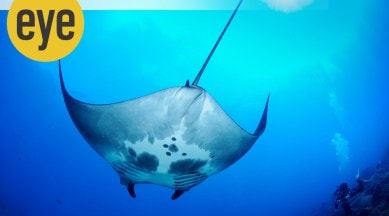What secrets do the creatures of the deep hold?
Be it the Orcas who are the wolves of the sea or the Manta Ray's seven-meter wingspan, the ocean is rich in biodiversity

Of all ecosystems, the oceans have the most bewildering and least-observed species-biodiversity. Last week, we met five favourites. The five mentioned here, just couldn’t possibly be left out – unique as they are in their own way:
Mudskippers: They really look like frogs that have gotten up to hanky-panky with fish – but these “air-breathing” creatures are actually fish that breathe through their skin and mouths, and cannot afford to “dry” out. Their eyes are perched on the tops of their heads, and they hop on the mud, doing push-ups with their pectoral fins, and using them to propel themselves over the mud. You can meet them (around 23 species world-wide) on beaches, estuaries and mangrove swamps. They can grow to 30 cm long and usually wear greenish or brownish uniforms – which males decorate with bright green, red or blue spots when out romancing. When so excited they may leap up to two feet and are able to climb low-hanging branches of mangroves.
Sharks: Possibly the most beautifully streamlined of fish, Mother Nature perfected their design 450 million years ago as top predators of the oceans. The film Jaws (1975) alas, doomed them forever, something its director regrets to this day. Of nearly 500 species found worldwide, only four or five are known to be dangerous: the great white, the oceanic white-tip, the bull-shark and the tiger shark. One estimate mentions there are less than 100 shark attacks on us every year. In turn, we kill 100 million annually, of which many just have their fins chopped off before being tossed back bleeding into the sea, so we can enjoy our shark-fin soup at boutique restaurants. Sharks have excellent eyesight and hearing and can sniff out one part of blood in one million parts of water. They also pick up minute electrical signals given off by bodies and when in pursuit, can top 90 kmph. They are armed with a mouthful of as many as 3000 serrated teeth – at any one time – a dentist’s dream (‘oh, sir you need root-canals – hundreds of them!’) and may use up 30,000 teeth in a lifetime!
You can stop a shark in its tracks by flipping it over on its back, when it enters a state of tonic immobility (some say its playing dead), which lasts around 15 minutes. Killer whales are known to deliberately flip them over, while hunting them. Certainly, sharks are more sinned against, than sinning.
Sea Turtles: There are just seven species of these sad-eyed reptiles in the world, of which six are endangered and all have the odds stacked against them. Though they may live for 150 years, only one in a thousand live to breed. Females, bury their eggs (between 50 to 350 depending on the species) on beaches, hauling themselves on to the shore, usually at night. They laboriously dig holes in the sand in which they deposit their eggs, cover them up with sand before returning exhausted to the sea, to be welcomed by waiting Romeos or maybe sharks! The mass arrival of turtles on a beach is called the “arribada” (arrival) and is quite a spectacle.
Turtle nests are often dug up by waiting predators (and us) with an appetite for eggs. Baby turtles emerge at night, struggle out of their nests and then scamper hell-for-leather for the sea, being mercilessly chased and picked off by predators (birds, dogs – and us) en route. Once in the water, they face the gauntlet of sharks, et al. It’s thought they know in which direction to scuttle by the faint light over the ocean being reflected by the stars or moon. Nowadays, lights from beachfront homes, hotels and roads, confuse them and many unfortunates head the wrong way.
If they do make it and survive, they will roam far and wide over the oceans, for years. When the time comes to breed, in some species, like the Olive Ridley, the females will navigate unerringly back to the very beaches they hatched from themselves so many years ago.
Manta Rays: With a seven-meter “wingspan”, manta rays wafting languidly through the depths are truly poetry in motion. They may occasionally even leap clear out of the water (rather like flying fish, but more gracefully). They are filter feeders, opening their mouths wide and taking in zooplankton as they swim. They have the biggest brains of all fish and brain-to-body ratio and are able to pass simple tests, including the mirror test for self-recognition. They are listed as vulnerable, and often get entangled in fishing nets and are hunted for their gill rakers (used to filter food particles) for use in Chinese medicine. They are slow breeders, and often land up at “cleaning stations” where other fish kindly remove their parasites.
Orcas or Killer Whales: One of the most demeaning sights I’ve seen is a gigantic, gleaming black-and-white patent leather killer whale leap and slither out of its tank and “kiss” its keeper in exchange for a piddly little sardine, at the San Diego Sea World, many years ago. Shows like this have since thankfully mostly been stopped.
Orcas are also known as the “wolves of the sea” and hunt very intelligently in packs. They have prodigious appetites and will relentlessly take down what they’re after, whether it is chasing penguins and seals right up to the beach or collectively creating “tidal waves” to sweep a seal off the ice. Smartly tuxedoed, they are not to be trifled with as any wolf on Wall Street.